Re-imagining Dance – Being brave, bold and brown.
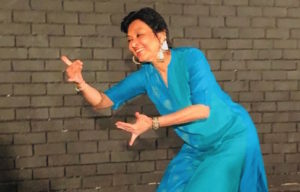
By Sudha Kumar
”˜Re-imagining Dance – Brown bodies on the global stage’ – An evening of conversation and classical dance performances. Where dance was reimagined by three women artistes – Dr. Mallika Sarabhai, Dr. Anita Ratnam, and Dr. Swarnamalya Ganesh who have made a significant mark in the world of Indian classical performing arts and now are using their art as tools in the space of expression to send a message, question and perhaps even challenge.
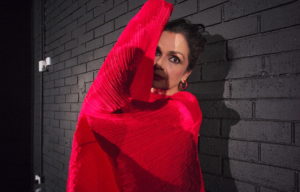
The evening opened with the vocal rendition of the verses of the famous Tamil poet Bharathiyar by Arjunan Puveendran accompanied by Kasthuri Sahathevan on the Veena. This set the tone for the dancers.
Dr Swarnamalya, a Bharatanatyam artiste and practitioner of ”˜sadir’ (the ancient name of Bharatanatyam), a scholar of dance history and an academic in art practice in Sociology, presented a ”˜shabdam’ composed by Raja Serfoji which incorporated the gesture of ”˜salaam’ or ”˜aadaab’– the Mughal way of greeting. At a time when much of the world is in religious turmoil, and in India when mythology is replacing historical fact, the presentation showed the amalgamation, respect and inclusiveness of different cultures in the realm of arts. This has only enriched the country, her people and her culture.
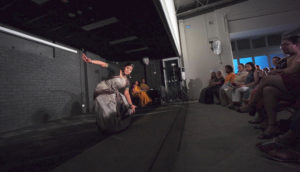
Swarnamalya in her performance celebrated what used to be.
Dr Mallika Sarabhai is a writer, publisher, and a classical dancer in the Bharatanatyam and Kuchipudi forms among other things. Womens’ rights holds a strong place in her approach to dance. In contemporary India, Dr. Sarabhai is a pioneer in using the art of dance to bring about social change. Mallika Sarabhai danced to a ”˜padam’ composed by herself, where she questions Krishna about the definition of ”˜love’. ”˜Why is it that certain types of love are accepted, applauded, blessed and even worshipped, while other types are harangued about, abhorred, and even killed for? Why the hate in the name of love’ ?
Sans the accessories of a typical Bharatanatyam performance it was pure expression with a strong message asking a pertinent question.
Dr Anita Ratnam, highly acclaimed and respected as a performer, writer, arts entrepreneur and culture mentor, is described as an ”˜intersectionist’. Interleaving of the many threads of classical dance forms with theatre, the spoken word and kinesthetics has resulted in a new language of expression and vocabulary which she has named ”˜Neo Bharatam’.
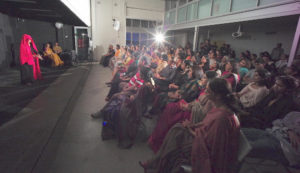
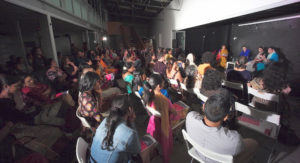
Involving the audience in her rhythmic beats she took them to another world as she danced the story of Soorpanaka from the Ramayana, but from the protagonist’s perspective. Soorpanaka who we know as an evil demoness was presented by Anitha Ratnam as the most bewitching damsel ”“ ”˜brave, bold and brown’ and focussed on chasing ”˜what was dear to her heart’. The story culminated with an older Soorpanaka sharing a common sorrow of loss with Sita.
Adorned in a costume atypical of any specific classical dance form and the most dramatic body movements, Anita Ratnam kept the audience rivetted. It was an audio-visual treat.

This was followed by a panel discussion moderated by Indu Balachandran. Covering a range of contemporary issues, from ”˜resistance to change, ”˜the significance of tradition in art’, to ”˜seeking a sense of identity through art’, the discussion was most interesting and relevant to our times. How do artistes who have a social message work around or break through resistance? How important is the role of tradition in art? Is there still a special niche in the contemporary world of arts for the classical artistes? What message can be offered to the younger generation of practitioners, especially in the Indian diaspora, who live with multiple cultural identities?
Some takeaways from the discussion:
To the younger generation who are practitioners of art ”“ ”˜there is no need to constantly seek approval. Embrace the present moment and express different ideas. Tell your story.’
Contemporary times have seen that classical art performances are few and far between. In a world of instant gratification it is the greatest challenge yet. Perhaps we are moving towards a new reality in classical art performances.
Tradition has a very important part in any classical artform to morph and attain finesse. There is a tradition in its choreography, practice and performance. Studying and operating within the framework of tradition brings the artiste to a point where he /she can then explore and experiment. In a world that is becoming increasingly polarized on defining what is ”˜pure’, ”˜authentic’ and ”˜traditional’, it has become most important to ensure that that very ”˜tradition’ does not come in the way of including, questioning, and evolving. That it is no obstacle to ”˜reimagining dance’.
This was evident in the presentations of all three artistes who are rooted in their traditional art forms and have then evolved to who they are today, making a mark on the global stage with their artform as the tool to effectively ”˜re-imagine dance’.
Dr. Mallika Sarabhai concluded the panel discussion- ”˜Any artform is an incredible language that has the immense power to break through prejudices, help find oneself and then become the best one can be – to yourself, your neighbour and the world.’
Art, any art, must express, or it ceases to be. Art in the public domain carries something beyond the technique, the story telling and the performance. It has the potential to carry a message, to challenge and even disrupt.
Art has a social responsibility.
It was an evening which fed to our aesthetic as well as our intellectual minds. All three artistes ”˜reimagined’ dance in their own unique way – in performance, expression and discussion.
The event was curated by Indu Balachandran and Arjunan Puveendran, and partnered by KREA University, Australia Council for the Arts and ICE ”“ Information and cultural Exchange.
Photo credit: Michael Chin.
Short URL: https://indiandownunder.com.au/?p=14968
